Recent Articles
Popular Makes
Body Types
2019 Kia Niro EV vs. 2019 Hyundai Kona EV: Which is Best?
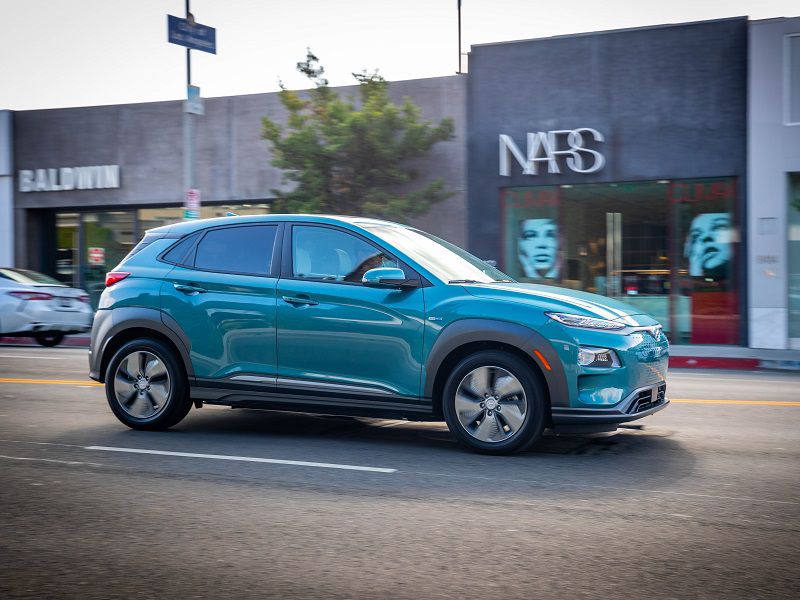
2019 Hyundai Kona Electric Blue Side Profile Driving ・ Photo by Hyundai
The 2019 Kia Niro EV and 2019 Hyundai Kona EV are among the latest crop of battery electric vehicles with genuinely useful range and affordable pricing. Since Kia and Hyundai are corporate siblings in the South Korean conglomerate Hyundai Motor Company, Niro EV and Kona EV share many similarities, yet are totally unique vehicles. Kia and Hyundai have separate management, sales, and marketing organizations, and distinct dealer networks.
A casual glance or brief test drive may not be enough to make a buying decision between the two EVs, so we’ve put together this deep dive to help you sort the apples from the oranges. Let’s discover once and for all, 2019 Kia Niro EV vs. 2019 Hyundai Kona EV: Which is Best?
Exterior Design and Dimensions
Both Niro and Kona are models available with multiple powertrains, from gasoline only to plug-in hybrid gasoline electric, to EV. Rather than radical differences between models, each design is subtly tweaked to its purpose.
Both Niro and Kona have sealed front grilles, since airflow is not required to cool a radiator or internal combustion engine, and a smooth front improves aerodynamics. Niro retains the shape of Kia’s signature shark-nose grille, while Kona has a textured faux grille in body color. Battery charging ports are concealed behind hinged covers in each vehicle’s front fascia. Niro is slightly larger than Kona, riding on a longer wheelbase (106.3 inches vs. 102.4 inches) with a greater overall length (172.2 inches vs. 164.6 inches), while both vehicles are roughly the same height and width.
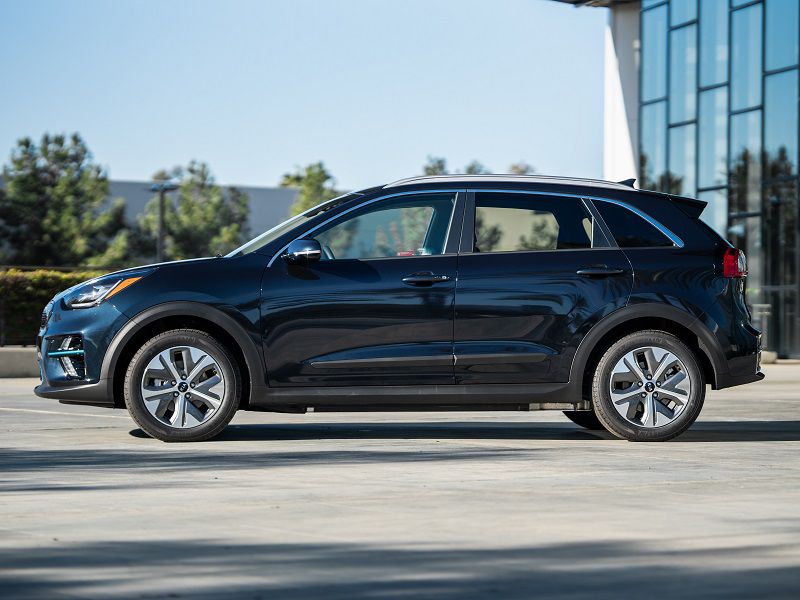
Photo by Kia
Interior Design and Dimensions
Interior design is one place where Kona and Niro differ. Kona’s design is cleaner and less cluttered, especially in the center stack. An available 8-inch touchscreen display (7-inch standard) floats above the stack at the top, supported by horizontal HVAC outlets and controls below.
In contrast, Niro’s 7-inch touchscreen (8-inch available) is embedded into the dash, and is flanked by vertical HVAC outlets. Two rows of controls are below that. Not only does the Kona design look better, it makes sharing climate control output with the second row more effective, and avoids blowing cold A/C on the driver’s right hand. Dimensionally, the two vehicles are very close. Niro grants more leg room to the second row, 37.7 inches vs. Kona’s 33.4 inches, which could be important to some owners.
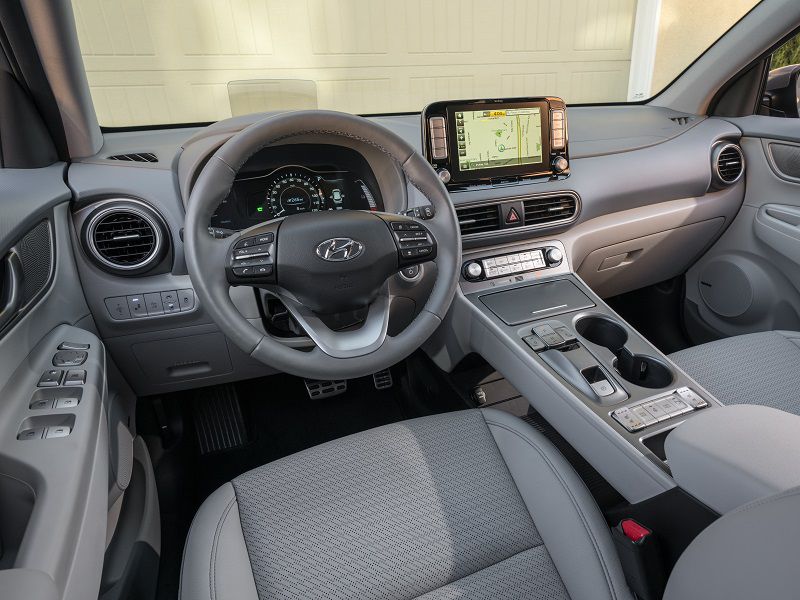
Photo by Hyundai
Cargo, Payload and Towing
There’s a reason that Hyundai and Kia chose the crossover SUV form for these EVs: It’s the “U,” which shows up mostly when you go to load up cargo.
As the larger of the two vehicles, Niro has better overall cargo capacity with the second row folded at 53.0 cubic feet vs. Kona’s 45.8-cubic-foot capacity. Behind the second row, Kona wins with 19.0 cubic feet of luggage space vs. Niro’s 18.5 cubic feet. Kona EV is rated to carry a payload of 926 – 1,076 lbs (depending on configuration), while Niro EV is rated to carry up to 1,062 lbs. Towing is not recommended for either vehicle.
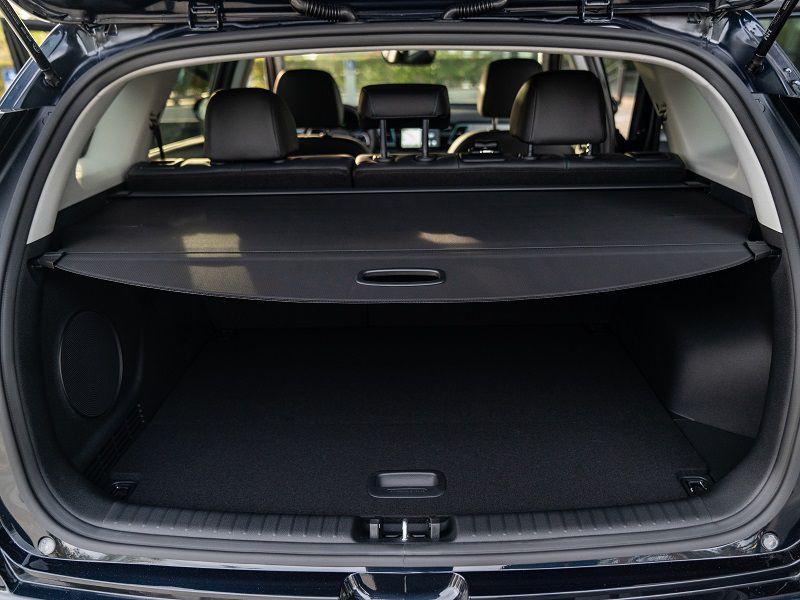
Photo by Kia
Electric Motors and Battery
Here’s one category where Hyundai and Kia’s shared parentage reveals itself most clearly. The two companies share technology and engineering resources, and Niro EV and Kona EV share identically rated motors and batteries. Each uses a permanent magnet synchronous motor that puts out 150 kW (201 hp) and 290 lb-ft of torque, and uses a 356-volt Lithium-ion Polymer battery with a 64.0 kWh capacity.
The battery can be charged using household current and the included charging cable. This can take up to 59 hours from fully drained to fully charged. A Level 2 charger (240 volts) speeds this up considerably to nine hours 35 minutes. If you have access to a 50 kW DC fast charge, that will take you to an 80-percent charge in one hour 15 minutes. A 100 kW DC fast charge can achieve that in one hour flat.
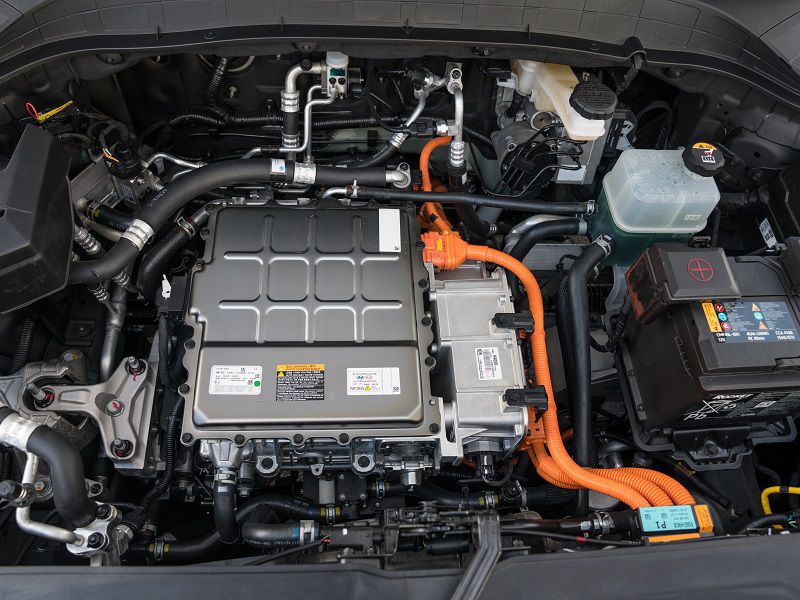
Photo by Hyundai
Transmission/Drivetrain
Both Niro and Kona are front-wheel drive vehicles – all-wheel drive is not available. Both use single-speed gear reduction units for transmission, a simple and smart solution for an electric-motor-driven vehicle. So, there’s no clutch to operate or maintain, no gears to mesh or wear out, and no drivetrain lash to modulate.
The drivetrain is pretty much direct, relative to internal combustion engine setups which require a separate transmission to get the power to the wheels. Kona has three drive modes: Eco, Normal, and Sport. Niro adds Eco+. Each vehicle uses regenerative braking to recapture energy and send it back to the battery.
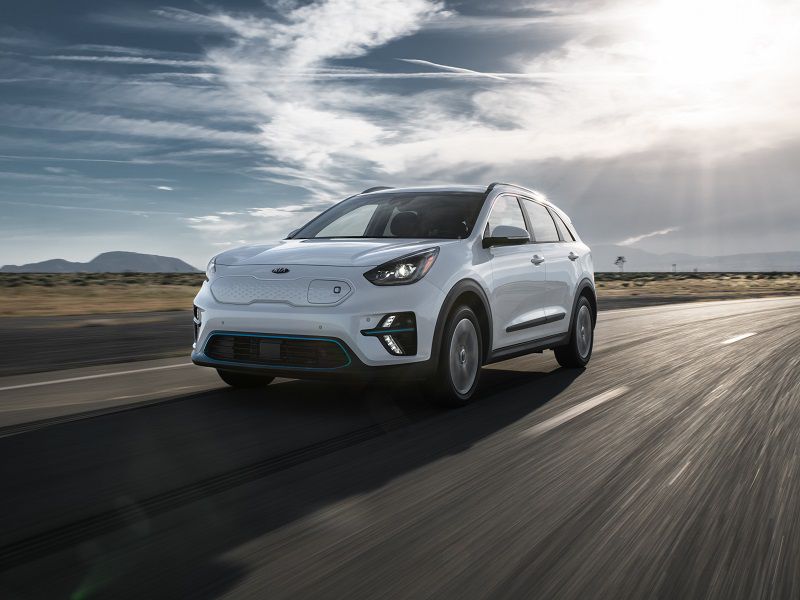
Photo by Kia
Infotainment/Technology
The 2019 Kia Niro EV comes with the latest version of UVO telematics that includes a smartphone app that gives owners the ability to receive notifications of battery and charging status, real-time charging station updates, scheduled charging, panic notifications, “send-to-car” points of interest and waypoints, and pre-conditioning of the cabin temperature. A six-speaker audio system is standard, upgradeable to an eight-speaker Harman Kardon premium audio system. Bluetooth hands-free and audio streaming, Apple CarPlay, and Android Auto all are standard.
The 2019 Hyundai Kona EV pretty much matches the Niro EV’s capabilities, with Hyundai’s Blue Link connectivity suite. Kona EV can be equipped with an Infinity premium audio system with eight speakers and Clari-Fi music-restoration technology. A head-up display also is available, along with smartphone wireless charging.
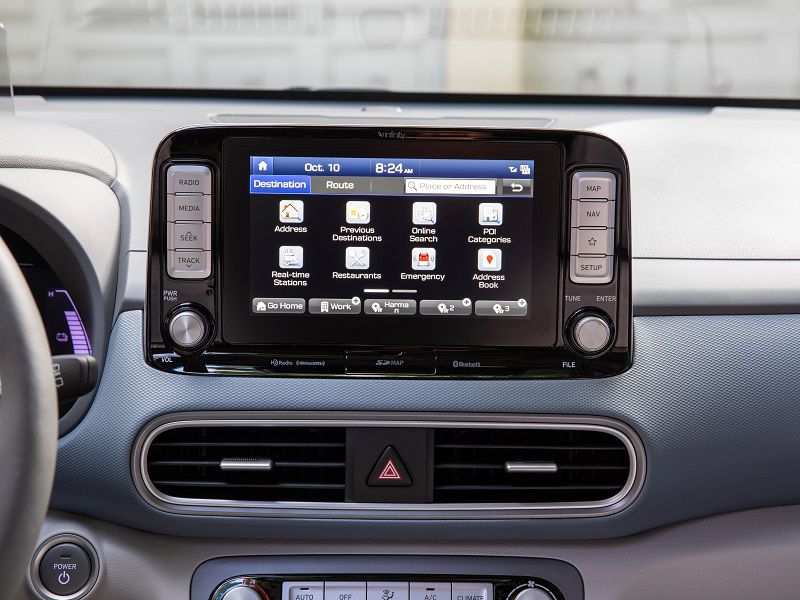
Photo by Hyundai
Safety/Driver Assistance
Kona EV comes with a standard front-facing camera, which enables standard Forward Collision Avoidance Assist, which can brake autonomously in certain situations to help avoid or minimize damage when it detects an imminent collision. The camera also makes available Lane Keeping Assist, High Beam Assist and Driver Attention Warning possible on Kona EV. Available radar systems include Blind-Spot Collision Warning and Rear Cross-Traffic Collision Avoidance Assist.
Niro EV includes the Kia Drive Wise Advanced Driver-Assistance Systems, which include Forward Collision Warning, Forward Collision Avoidance Assist, Lane Departure Warning, Lane Keeping Assist, Blind Spot Collision Warning, Driver Attention Warning, Smart Cruise Control with Stop & Go, Rear Cross-Traffic Collision Warning, and Parking Distance Warning Front and Rear (available).
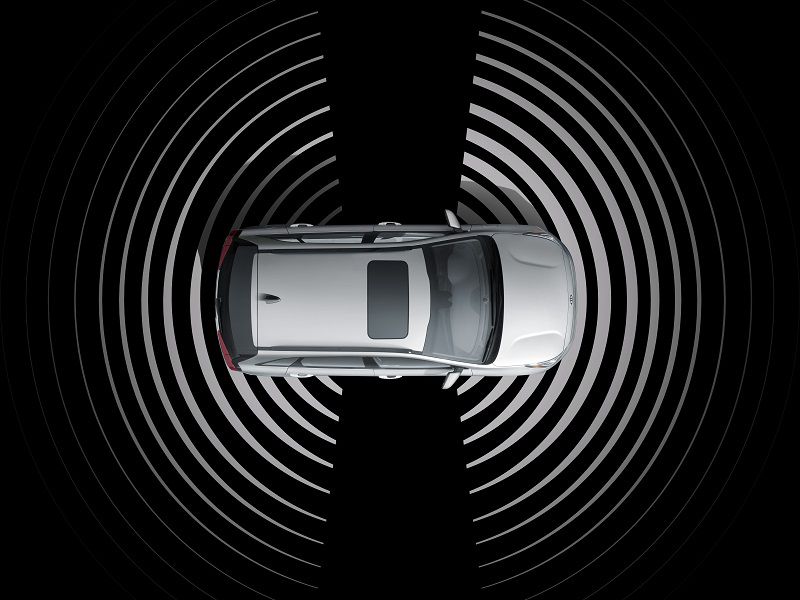
Photo by Kia
Driving Experience and Range
Both EVs deliver great, linear acceleration. Kona can scoot from 0 – 60 mph in 6.4 seconds, while Niro is a tenth of a second slower, probably because it weighs about 150 lbs more. But standing starts aren’t the best part – it’s the instant peak torque available whenever you want it, allowing you to scoot through gaps in traffic like a bug. Kona’s shorter wheelbase makes it feel a little dartier, though not uncomfortably so.
Both vehicles require some care during acceleration, as steering gets a little light, but everything’s easy to get used to and predictable. Both Kona and Niro are incredibly quiet during operation – so quiet that they must project artificially generated whirs to alert pedestrians to their presence. Niro is rated to travel up to 239 miles on a single charge, while Kona is rated for a range of up to 258 miles.
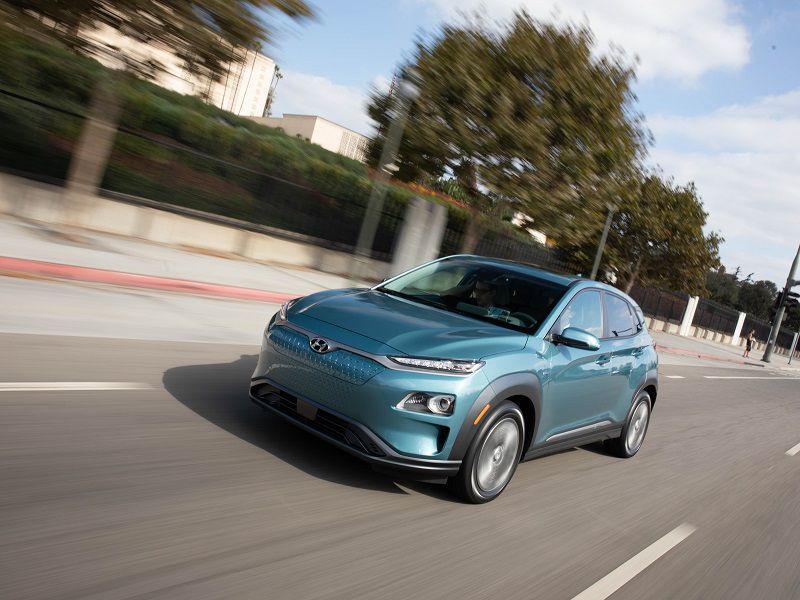
Photo by Hyundai
Pricing and Availability
The 2019 Kia Niro EV is available at dealerships in 12 states: California, Connecticut, Georgia, Hawaii, Maryland, Massachusetts, New Jersey, New York, Oregon, Rhode Island, Texas, and Washington. It is available in two trim levels: EX, starting at $38,500; and EX Premium, starting at $44,000.
The 2019 Hyundai Kona EV sales began in California, and have spread to ZEV-focused states in the western and northeastern regions of the U.S. It is available in three trim levels: SEL, starting at $36,950; Limited, starting at $41,400; and Ultimate, starting at $44,900. Each EV qualifies for federal and state tax rebates, where available. Base models are well-equipped in both cases, and powertrain features are identical up and down the lineups.
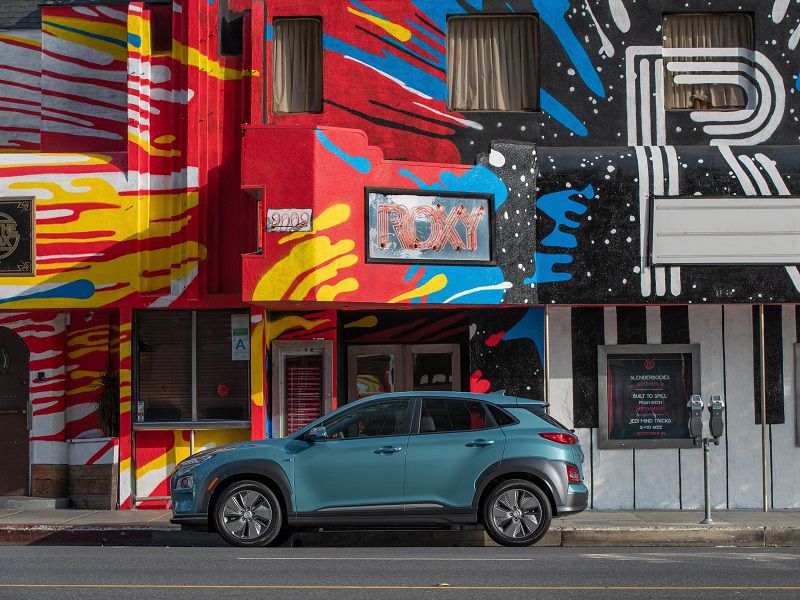
Photo by Hyundai
Recommendations
If you live in one of the lucky states where the 2019 Kia Niro EV and/or 2019 Hyundai Kona EV are sold, it’s time to figure out if an EV suits your transportation needs. An EV is not for everyone or for every driving purpose, certainly. But with ranges of over 200 miles per charge, both of these crossover suv EVs can be very useful and efficient partners. You should also check out the Tesla Model 3, Nissan LEAF Plus, Volkswagen e-Golf, Chevrolet Bolt, and other EV models to see how other manufacturers are approaching the transportation revolution that is the electric car.
The margin between the Niro EV and Kona EV is razor-thin, but thanks to a roomier second row and more attractive exterior styling, we’re landing on the side of the Niro EV.
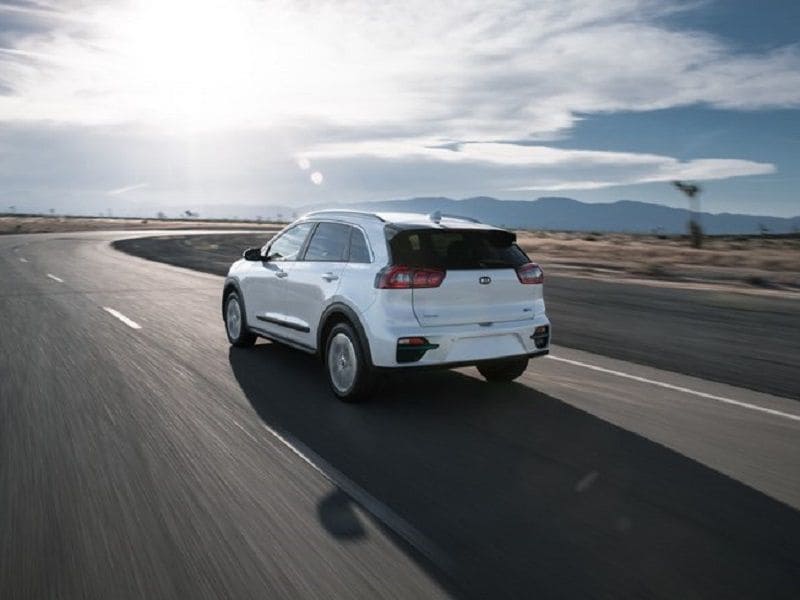
Photo by Kia